White hair color: who suits and how to dye without yellowness?

Every woman probably thought about the white hair color: it is interesting to try on the image of a blonde. But the blond blond is different - there are several dozen shades of hair that can be attributed to this category. And not everyone decides on frosty white.
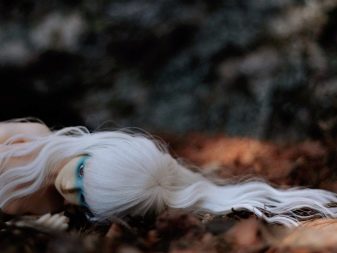
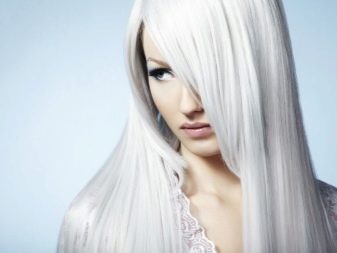
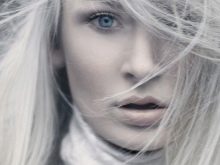
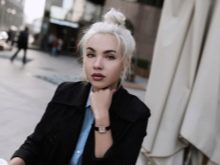
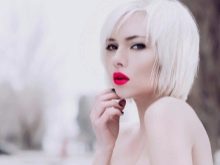
Peculiarities
If we consider the structure of the hair, then a strand devoid of pigment is considered white. And only albinos can have such a natural color, which means that it is a priori an anomaly. In all other cases, white is the result of staining. If you are in the mood for a white hair color, you need to understand that this choice is not entirely common. You will not just have a light shade, powdery, beige or faded wheat, but white - like a paper sheet. It should be noted that this is also a cold color.

In one case, white can rejuvenate, in the other - make the image cheap, vulgar.
You may have to change the entire wardrobe, decorative cosmetics, jewelry, because the white hair color significantly changes the whole look. For organicity, you will have to clearly select a new make-up, style. And it is impossible to answer right away how successful the transformation experiment will be. But if you naturally have a Nordic type of appearance, the image is likely to work out.

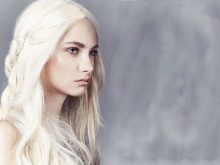

Who is it for?
Whether or not this shade suits you is a secondary question. The first thing that needs to be answered is whether you are ready for such changes. Hair color is so bright, radical that it overlaps with all other accents. For young girls, such stylistic experiments are familiar and often successful. Young skin, clear oval of the face, slimness, current make-up help the new color to become a part of the image, harmoniously and easily adapt to serious external transformations.For middle-aged and mature women, not everything is so simple. Boiling white hair color is suitable for women who are well-groomed, with a very good tone and perfect face sculpture.


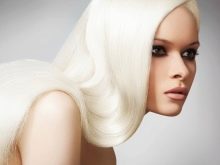
Of course, not everyone who chooses white meets these criteria.
White will suit the following types.
- Women with perfect even skin tone. It is not so important whether the tone is dark or pale, the main thing is even (without a noticeable capillary network, irritation and redness, visible wrinkles and age spots). Whether you are a Nordic girl with aristocratic porcelain skin or a lady with a warm peach tan, white can be a good hair color for you. But for dark-skinned women, freckled girls and owners of olive skin type, white is not an option.

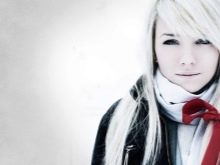
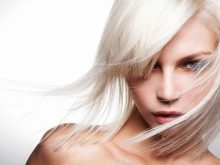
- Blue-eyed women. Brown and green with a certain skin tone can also give an interesting combination, but nevertheless blue eyes + snow-white hair is already a classic of the genre. Think of Barbie, and all questions will disappear.
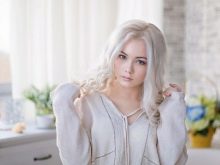


- Fair-haired. If you have naturally light blond hair, chances are good that white will make friends with you. And the dyeing will be successful, yellow and red strands when dyed are unlikely.



But the main thing is that a cold blond is suitable for purposeful women who clearly understand that beauty requires sacrifice.
As much discoloration as white offers, not every hair will handle.
And if you do not yet support your hair with various restorative and auxiliary procedures, you will not have to admire a new hairstyle for long. Therefore, if you choose a cold blond, get ready to spend time, effort, money on hair care. No other colors require such systemic, precise and constant maintenance.
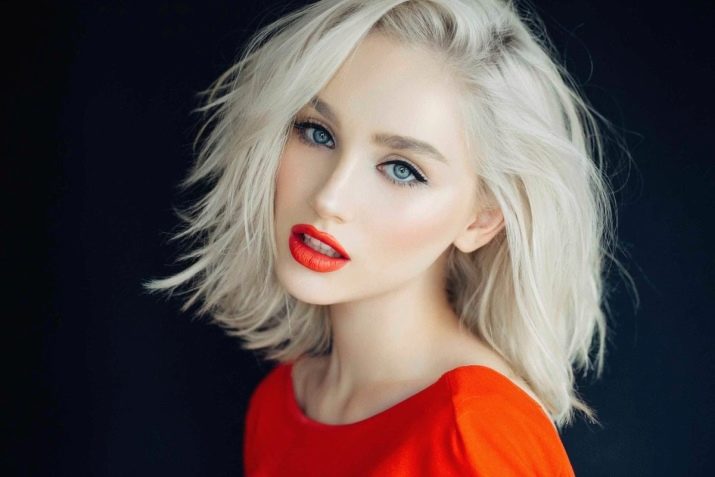
Palette of shades
Shades of blond, as already noted, are multifaceted. And even the snow-white color has neighbors. Here are some popular variations of white.
- Classic white. Absolutely white hair, without tonality, shades, even subtle.
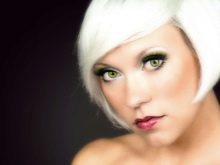
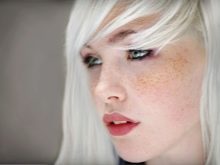

- Golden white. The golden undertone is barely noticeable, especially in the evening light.
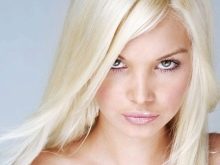


- Platinum. The most popular color of the palette, light grayish notes are guessed in it. It is no longer pure white.
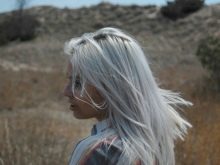

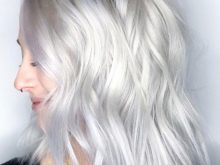
- Linen. This blond has a gray or yellow undertone.
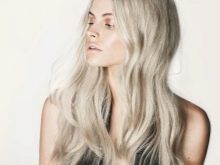
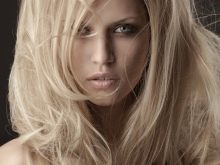

- Ash white. Fashionable color with a slight tint of ash. It is no longer bright white, due to the bias in the gray-blue palette, it looks defiant, but at the same time stylish.
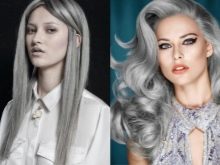


Most women want to get a snow-white color, inspired by someone's images. And this is understandable: in the photo, the stars are so good, so organic that it seems worth repeating the success of the celebrities.
Do not forget about rational analysis, and in order to impress and admire white, you need to enlist other features of your appearance.
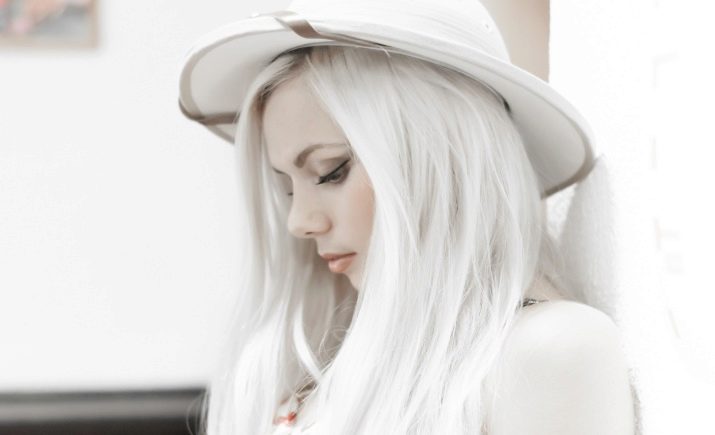
Let's take an example. Of young women, one of the most popular, cited stars in terms of photo and video is model Alena Shishkova... Now the ex-girlfriend of Timati has returned to the natural light wheat color. But for several years she was considered a Russian Barbie due to a chiseled figure, incredibly long legs, blue eyes and snow-white hair. As you can see, hair is "attached" to other virtues. And without a perfect figure and a beautiful face, white might not have looked so impressive and expensive.
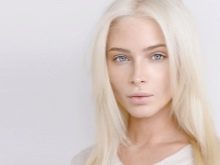


How to dye your hair?
If the decision is made firmly, you need to implement it. And getting a snow-white color without yellowness, spots and transitions is a difficult task. Therefore, you should not do this at home, you can achieve the opposite result: the hair will have to be repainted, reanimated, saved. But if you are determined to do everything yourself, at least study the instructions. For painting you will need:
- rubber or plastic gloves (usually included with paint, but not always);
- comfortable hairpins / hair clips;
- comb;
- bowl for composition;
- application brush;
- fat cream.
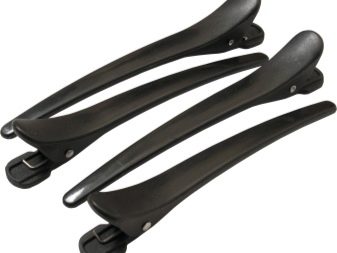
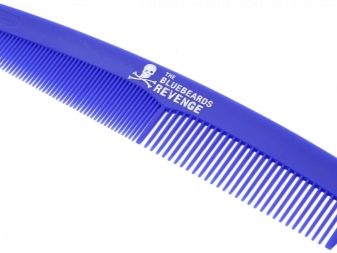
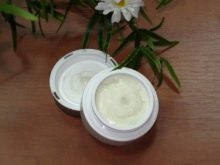


The cream is needed so that the skin at the border of hair growth is not painted over. It should be applied to these areas before painting.
Dilute the paint strictly according to the instructions, just before painting. The staining process consists of the following steps.
- Divide the hair into 4 parts with parting - from the forehead to the back of the head and from ear to ear. Pin or pinch each part.
- Put on gloves. Staining begins at the root zone, moving from the forehead to the back of the head. But not all masters adhere to this scheme, believing that it is necessary to start from the back of the head. There, the skin is colder, which means that staining will be slower. Remember which pattern your favorite master is following, and repeat. If there is no such example, intuitively choose the appropriate method.
- If starting from the front, remove the clip, separate a small section (about 1 cm), paint over it on both sides with a brush. Repeat all this until you reach your ear. Repeat the same on the other side.
- Move on to coloring the back of the head. Take off the hairpin / clip, make a side parting from the top of the head, paint over a strand, fold it back. Make a new parting, repeat the movement. Paint over the last stabbed part in the same way.
- At the end of dyeing, lift your hair up. After about 25 minutes, gently comb through the strands to ensure an even distribution of the product. Do not overexpose paint for longer than the time indicated on the instructions.
- Rinse off the dye, rinse your hair with slightly acidified water.
This scheme is a basic, but not a strict set of rules.
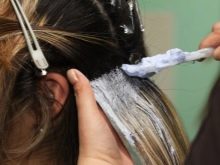
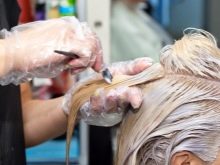
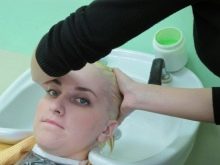
Be guided precisely by those instructions that are indicated in the instructions.
Remember that if your original color is unfavorable for dyeing white, the chances of getting the desired shade are very small. Most likely, you will have to repaint the unsuccessful result. Whether or not to leave black roots is a matter of individual consideration. Fashion assumes different options: with dark roots, and with Scandinavian snow-white hair straight from the scalp, from the border of hair growth.
The main problem of painting in white is the appearing yellowness and reddishness. If these negative phenomena have appeared, it means that the base has not been sufficiently clarified. Perhaps the point is not the highest quality tinting dye. Moreover, not all tint hair after lightening, if such a procedure is supposed. But if you do not tint, the blond will turn out to be straw. For this reason, try to get to the master for the first dyeing: he will assess the initial condition of the hair, give predictions for successful dyeing, discolor and tint the hair, and also advise a home tinting agent that will “keep” the color.
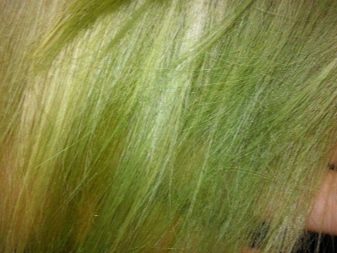
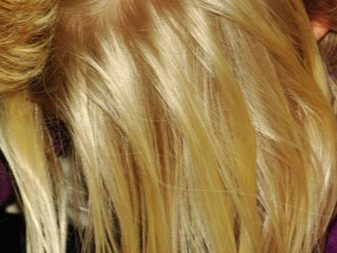
Care after staining
First and foremost - do not harm your hair, let alone lightened and tinted - do not double harm. If you have sulfate in your shampoo, the blond will suffer from it. Sulfate quickly flushes pigment out of the hair, making the curls lifeless, dry and brittle. Finally, the very yellow and red shades of hair are often given by sulfates.
Another enemy of bleached hair is alcohol. Do not use funds with its content at all or reduce their use to a minimum.
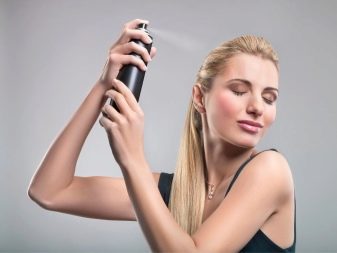

Hairspray is considered the most purchased styling product, but it especially hurts blondes. Due to the alcohol composition, the clarified curls lose their smoothness, shine, and moisture residues. Under the action of the varnish, the cuticle of discolored hair opens, because of this, the ends begin to split, dryness and brittleness appear.
Also worth mentioning is smoking as the main enemy of blondes. It will surprise someone, but cigarette smoke seriously dries hair, it becomes dull and faded... It easily penetrates the structure of bleached hair, making it brittle. Porous hair (and this is how they are in the first days after lightening) very quickly absorb nicotine. Finally, hard water is also a blonde's enemy.
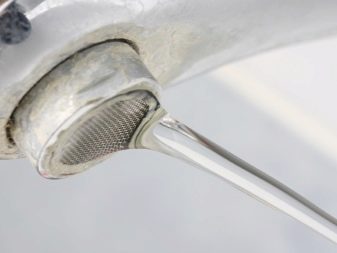
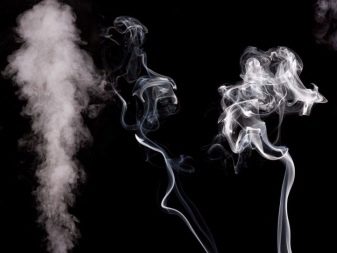
Minerals from hard water settle on the hair, curls lose their natural elasticity, but their color can also change towards yellowness.
Care after clarification includes the following points.
- Special caring cosmetics have been developed for blondes. For the first 2-3 weeks, actively use products for maintaining blonde and hair restoration. Special mousses, conditioners, masks and serums will help your hair survive bleaching less painfully.

- Ampoules with oil, serums for shine curls, restoring mousses - an integral component of care, as after lightening the hair becomes porous. They reflect light unevenly, which makes it seem that they are colored unevenly. Therefore, cosmetics for blondes are so important to restore, and you need to use it from the very first days after lightening.
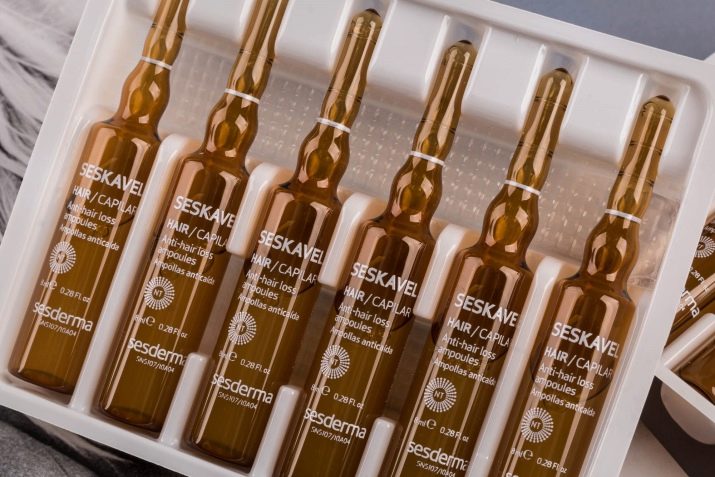
- Use masks and mousses at least once a week. Bleached hair, like no other, needs intensive nourishment and smoothing, which is what such cosmetics provide. Choose products with vegetable oils, amino acids, keratin, plant extracts.
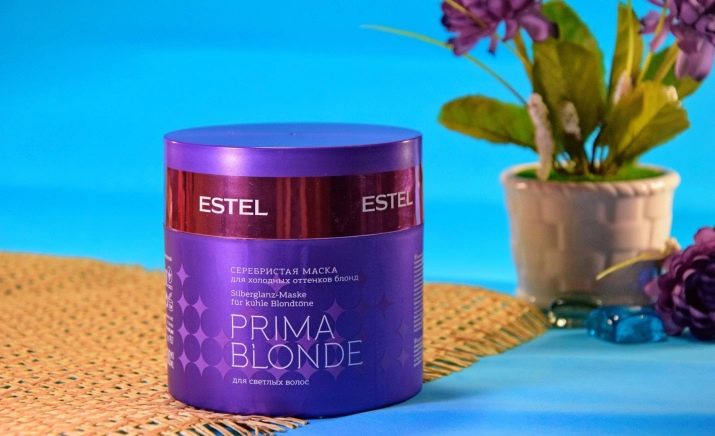
- The ends of the hair can benefit from the regular application of oil elixirs. They protect and nourish the strands, smoothen, add shine. The composition should not contain synthetic, but natural oils.

- Toning shampoos and balms - "do not wash" - these are funds with which blondes practically do not part, who have chosen white. For a high-quality effect on hair, tint pigments need time, so leave them on the hair for 7 minutes, if the hair is light - for 3-4 minutes. And so that the pigment does not accumulate, tint your hair at every fourth shampooing.
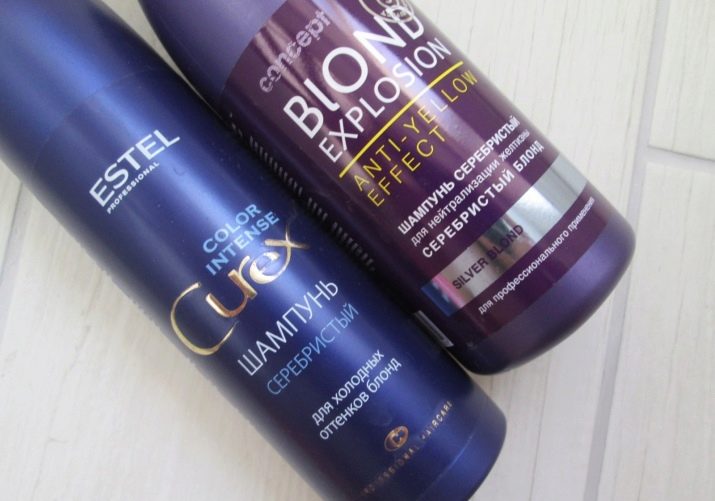
- Don't forget about thermal protection for curls. - the blond needs it especially. Protect your hair, protect from the scorching sun. Try not to do often complex hairstyles, braiding.
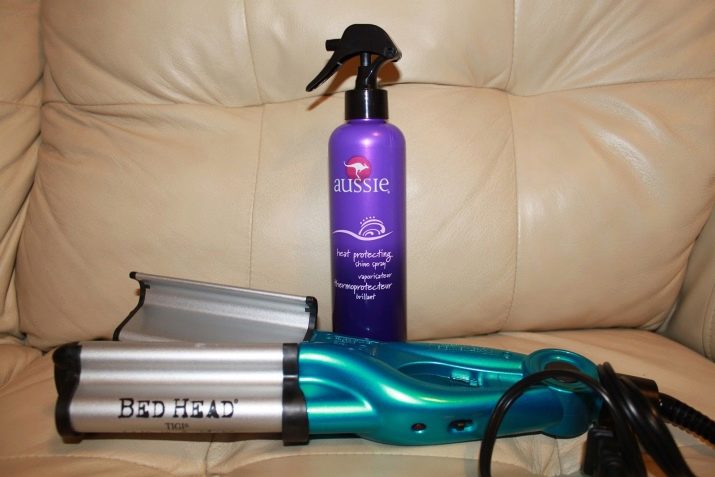
And, of course, complete the look with a suitable make-up, clothes ornaments. If you are a light-skinned, blue-eyed girl with snow-white hair color, this appearance requires an appropriate style. Light colors of clothes, light textures, soft solutions will only emphasize your fragile, delicate image. If you have dark eyebrows, expressive eyes and facial features, then to combine this with white hair color, you need a good haircut, the right face tone and an impeccable make-up. Try with care, take care with the utmost care and enjoy the results!
How to dye your hair white, see below.








